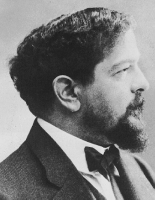
The pentatonic scale is comprised
of the notes do, re, mi, so, and la of a major scale (the five black keys
on a piano, F# Major). Students are most familiar with the
pentatonic scale in American folk songs.

============================================================================================================
The following is an example of a G Pentatonic Scale.
Click Here to listen to example.
Claude Debussy used the simple pentatonic scale and
composed a composition that sounded very strange to the audience.
Claude Debussy used the pentatonic scale in his composition
La Cathedrale Engloutie.
Click Here to go to the Classical Archives website which has a recording of La Cathedrale Engloutie.
At the website click on La Cathedrale Engloutie to listen to the recording.
[MIDI] Preludes Book 1 - 10.La Cathedrale Engloutie [7:15] (J.E.Dery)
Click on the back arrow of your browser to return to this page.
As you listen to the music, pay attention to the tonality and try to notice the sound of the pentatonic scale throughout the composition. You will notice that the harmony and sound of the music does not sound like the simple pentatonic scale in the above. Debussy's genius lies in his ability to take a simple pentatonic scale and make it sound very different and strange. Many people thought the music of Twentieth Century Composers was very strange and many did not like the strange tonality of their music.
Click Here to go to the Classical Archives website which has a recording of La Cathedrale Engloutie.
At the website click on La Cathedrale Engloutie to listen to the recording.
[MIDI] Preludes Book 1 - 10.La Cathedrale Engloutie [7:15] (J.E.Dery)
Click on the back arrow of your browser to return to this page.
As you listen to the music, pay attention to the tonality and try to notice the sound of the pentatonic scale throughout the composition. You will notice that the harmony and sound of the music does not sound like the simple pentatonic scale in the above. Debussy's genius lies in his ability to take a simple pentatonic scale and make it sound very different and strange. Many people thought the music of Twentieth Century Composers was very strange and many did not like the strange tonality of their music.
============================================================================================================
Works Cited
 Claude Debussy born Aug. 22, 1862, Saint-Germain-en-Laye,
France
Claude Debussy born Aug. 22, 1862, Saint-Germain-en-Laye,
France